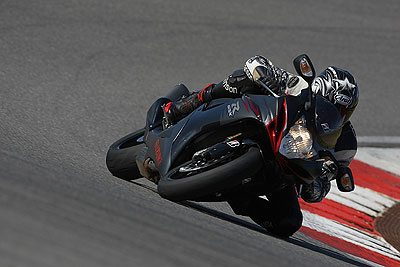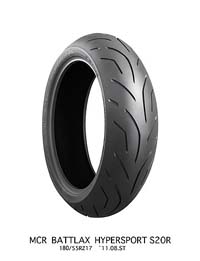Bridgestone Battlax Hypersport S20
Portimao Portugal, March 14, 2012
In the cruel sandbox culture of international finance callous analyst toss around the term “the PIGS of Europe”. The acronym refers to the countries experiencing severe debt issues which threaten the stability of the EU. The P is for Portugal, I is for Ireland, G is for Greece and the S is for Spain.
Although the dynamics which lead to the current predicament on the Iberian peninsula are complex and multi-faceted the simplified version is that Spain and Portugal built copious condos to sell to British and German vacationers. All those condos required big infrastructure upgrades (water, roads, sewers, etc) and the countries borrowed against the prosperity generated by the vacationing/retiring Northerners to finance that construction.
When the music stopped Portugal began to have trouble meeting its loan payments and is currently creating a headache (along with the rest of the 'IGS') for politicians, bankers and economist. Not to mention the actual citizens of these countries that currently are suffering unemployment rates 200% to 300% higher than the USA.
However, real estate bubbles do have their upsides for motorsports fans. Autopolis is one of the most beautiful tracks in the world. It was built at huge expense in Japan at the height of their bubble 20 years ago. The investors that lost their shirts on it have long since written off the construction costs but the world is left with a beautiful race track.
VIP stands at Portimao.
Somewhere, someone, is staring a spreadsheet and wondering why they ever thought it was a good idea to loan someone millions of dollars to build a race track in Southern Portugal and then build all the roads required to get to it. Somewhere, someone is downwardly adjusting the value of Portimao race facility to match current market prices but when the bankers eventually take the haircut on their Portugese bonds they can’t take away the gift to the world’s motorheads that is Portimao race circuit.
Pit lane at Portimao and a long line of machines.
It’s what Barber should have been. Four hairpins, Six blind turns, more elevation changes than any track has a right to. A fourth gear final turn leading onto a straight long enough to catch 6th, even with stock gearing. And if the camber changes were not sufficient to keep riders honest, the F1 cars have added a few well places bumps and ripples to work the suspension and tire hard.
And it was tires I was there to test.
Bridgestone is a massive Japanese tire company with a large OE fitment program. However, in the 1990s they let their production race tire product line grow outdated. Without the technological push provided by competition, their street tires atrophied until Bridgestone had a somewhat pedestrian image in the US. They blew the cobs out by going toe to toe with Michelin in MotoGP in 2002. They suffered through the steep learning curve which included last place finishes and terrifying catastrophic tire failures.
Michelin respond to the threat by building incredibly elaborate tires with infinite gradients of tire compound custom built to their rider’s whim and test date, all on the day before the race. However, this practice was outlawed by Dorna leaving Michlin struggling to provide a competitive all around tire, instead of specialty one off race tires.
Bridgestone moved to the front of the grid and rapidly top riders began insisting their teams switch from Michelin to Bridgestone. Eventually Dorna threw in the towel and adopted the single make tire scheme in place today. The unintended consequence of the rule is that now all the MotoGP bikes need to be constructed to match the characteristics of the tire, instead of the tires being built to match the bikes. Designers who fail to adapt to this will struggle mightily. I’m looking at you Ducati.
Bridgestone went back to a steel belt (from Kevlar) for the S20.
To mimic the feel of Kevlar they made a steel belt out of five small
strands of steel instead of one thick wire.
Bridgestone’s strength at building a tire with broad performance is amply embodied in the new S20. The S20 is designed to be a track day and general riding tire. It is going to replace the BT16 and BT16 pro (although they are going to stick around as a less expensive option although the S20 should give longer usable tire life so it is probably cheaper per mile) and the S20 overlaps the bottom end of performance for the BT-003 and the high end of the more street focused tire the BT-023.
Citing fast wear in the acceleration zone of the rear tire on their BT 016,
Bridgestone reverted to a three compound from a five compound tire for
the BT016 PRO. For the S20 Bridgestone extended the soft compound
further up the sides of the front for more cornering grips and extended
the medium compound further from the center to edges on the rear for
greater durability from hard acceleration.
To get the basic feel of the complex Portimao I grabbed a 2012 R6 shod with a 180 rear. Without any plan for how to ride the track I was often a gear too high and trail braking mid-turn. Even at the mild pace and mis-use of the equipment the tires exhibited no deficit of traction or feel at the low operating temperature. However, the R6 is not exactly a torquey bike so I grabbed a GSX-R 750 for my next session.
The compounds in the S20 have been reengineered to give greater grip in
wet and dry as well as working across a broader temperature range. This
means they work much better when they are running hotter as well as
colder than the BT016 pro. Since worn tires run at colder temperatures
(less internal friction in the rubber compound) this means the tires will
provide better performance even as they wear.
The GSX-R 750 is one of the best all around sport/track bikes. However, it steers slower than the R6 and it’s a lot faster. With my newfound knowledge of which way the track went I started moving up my braking markers towards the apexes. Higher entrance speeds only made the tires feel better. The front would bite hard even when loading the front through a combination of topography and steering input. Gearing down to second for the hairpins would cause the 190 rear tire to start smearing predictably from the apex to the exit curbs. It wouldn’t break lose and spin up, it would just hang out a little. The front still allowed for feel and precise steering even while cresting off camber turns across ripples.
The new tread pattern puts more rubber on the tarmac at all lean angles
for the front tire compared to the BT016Pro. The rear has more rubber on
the ground from vertical to about 22 degrees of lean and from 38 to 45.
It has less rubber on the road from in that middle part but they had to
make room for the water to go somewhere.
After two sessions on the GSX-R I grabbed the RSV4. The bike has a baffling array of modes and traction control settings but fortunately Motorcyclist’s Ari Henning had raced one for a year so I deferred to him to punch in the best profile. I had ridden an RSV4 before but, without the Ari settings, it was a dog. This one was not.
It had the ergonomics of the R6 and power of an R1. It was nimble, responsive and very fast. It was fitted with the 200 series rear. At a 95% pace there was not a single tire induced moment of doubt. The traction control on the big Aprilia allowed the tire to hang out a little without spinning up. But the tire was generating ample traction because the bike felt like it was trying to tear itself out of my hands at the exits of some of the turns.
The new compound distribution holds up admirably.
The pure pleasure of being drenched in Mediterranean sunshine astride an exotic Italian beauty on an exquisite race track somehow crowded out the obvious fact that I was sharing this track with a number of other riders. Some of the riders, who are no doubt good people, were of dubious familiarity with riding at speed on race tracks.
I caught up to a pack of three over a blind table top leading to a hard braking zone. Of course, there was no reason not to just back off and wait for a wider spot to make my passes, except I didn’t. Trying to maintain my lap time (which, as far as I knew, was not actually being documented but some habits die hard) I lined up to pass the first one on the brakes. The rider apparently didn’t like the line he was on, and moved over to take mine. Committed to the pass I moved over further, onto the inside curbing, on the brakes.
I know that it is that fancy GP high friction paint but hard braking on painted curbs is still a pucker moment. The tire didn’t budge and the bike didn’t squirm.
The doubts from a tenth of a second ago were immediately replaced with the desire to get by the next two bikes in front of me. I caught the next one on the exit with early, and aggressive throttle application. The rear tire pushed me past with no drama. We arrived at the last of the hairpins where the third rider was indecisively wandering around trying to decide exactly where he wanted to turn in. I knew better, I do know better- but I tried to dive underneath him anyway.
I was carrying a few more kph and was already intent on apexing on the curbing when he unnecessarily, but totally predictably, decided to join me on the inside. I had the choice of contact or going for the front Brembos. On my knee, I went for the brakes and somewhere some voice was saying “What a great test of the front tire!” My collar bone, Arai and Aprilia all owe a debt to the Bridgestone front tire design team. As the weight transferred to the front and the rear suspension extended I kept anticipating the sick feeling of the handlebars folding away from me. It never happened. The tire stuck.
Apparently the more important determination of the tread pattern is its aesthetics.
The next day I grabbed an FZ1 for a 100k ride through mountains. Apparently this province had not borrowed enough money for road projects beyond extending the highway to the race track. Some of the route was normal freeway but much of it was 1.5 lanes wide with a motley collection of frost heaves, wet and dry pavement, seams, the occasional tractor and even a donkey cart or two.
The tires gripped the traffic circle pavement straight out of the parking lot. They required no warm up and were comfortable and stable. They even handled the odd gravel road and donut with aplomb.
The S20s deliver on the promise of being able to commute during the week, and ride at the track on the weekend, without needing an extra set of rims and at a promised price that won't require defaulting on your bonds.










